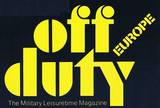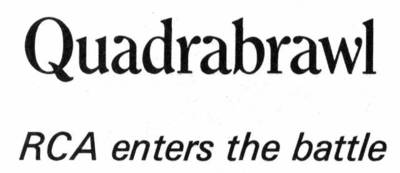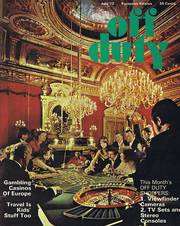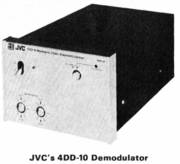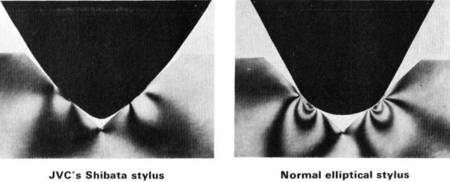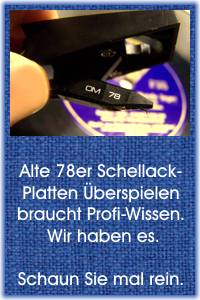"off duty" 1970 - 1997 - eine Freizeit-Zeitung für's US-Militär
Die in diesem amerikanischen (Freizeit-) Shopping-Magazin angepriesenen Hifi- und Video-Produkte waren auschließlich amerikanischen und kanadischen Militärangehörigen zugänglich - also zu kaufen - und vor allem zu ganz ungewöhnlich (verblüffend) niedrigen US $ Military-Preisen. Zu der einführenden "off duty" Seite geht es hier lang. - Um 1970 begann der weltweite Hifi-Boom bis zum 1. Crash 1978 und dann wieder zum 2.Crash um 1990. Über die 20 Jahre nach 2001 lesen Sie mehr in den Kolumnen auf diesen japanischen Seiten.
.
Es gibt etwas Neues in der Quadro-Welt von RCA und JVC
Juli 1972 - Bislang bewarben sehr wenige Firmen die SQ und QS Quadrophonie auf modifizierten Stereo-Schallplatten. Dabei wurde von den Redakteuren der diversen Hifi-Magazine einiges an Ungereimtheiten aufgedeckt. Das soll jetzt alles anders werden. Es ist (für mich) aber etwas sonderbar, diese difizilen Unterschiede dem einfachen GI klar zumachen, der gerade mal versteht, wie das mit dem Stereo überhaupt funktioniert. In dem Artikel geht es ans Eingemachte, und da wird doch etwas mehr an Fachwissen vorausgesetzt.
Dieser Artikel vom Juli 1972 zeigt, erst im Mai-Juni 1972 ging der Kampf der Quadro- Systeme richtig los und am Ende hatten alle verloren. Ab 1976 war dann fast überall Schluß mit Quadro, die Kunden haben den ganzen Hickhack nicht akzeptiert und mit den Füßen abgestimmt. Sie kauften das einfach nicht, teilweise war es auch viel zu kompliziert.
.
Quadrabrawl - "RCA enters the battle"
Über die "Schlachtfelder" der beiden Giganten RCA und CBS
AS THE BATTLE lines are drawn between giants CBS and RCA in their contest over 4-channel systems, the recorded music industry, along with its army of hardware manufacturers, is dividing into two camps called "matrix" and "discrete." Each in its own way claims to be compatible with existing stereo systems and insists that the other fellow's system is incompatible.
For starters, RCA converted its 8-track cartridge to 4-channel, employing four separate "discrete" tracks for each program instead of the usual two used for stereo. And it announced that it would steer clear of any derived-4-channel system for vinyl records and work instead at developing a discrete-type method of producing the equivalent 4-channel disc.
Meanwhile, rival CBS went matrix, with a recording system called SQ. Developed by Ben Bauer of CBS labs, SQ uses an encoder to convert 4-channel sound sources to a pair of signals that can be broadcast in conventional stereo, recorded on conventional stereo tape, and cut into vinyl discos that differ only a little from stereo LPs - except that these encoded stereo signals can be decoded (with a reverse matrix) into four channels in playback.
Verwirrend - es gibt bereits mehrere "matrix systems"
There are other matrix systems, notably those of Sansui (known as OS) and EV. Similar to these are Fisher's 2+2, Kenwood's QR and Pioneer's Quadralizer.
To clear the air, let's call this group "conventional matrix" or simply "matrix," because the difference is minimal. The SQ system, on the other hand, has an unconventional matrix formula, so that CBS's newly released SQ records may not sound quite right when played through conventional matrix decoders.
Just when the matrix camp is on the brink of getting its housekeeping in order, here comes RCA with the discrete disc, and the battle is on.
The batttle is on - die Schlacht geht los.
Called the Quadradisc, it's a refinement of the CD-4 system introduced in 1970 by Japan's JVC-Nivico. With CD-4, four discrete signals (like those on RCA's Q-8 tapes) are multiplexed into the disc, not unlike the way FM stations multiplex a stereo signal.
In CD-4, each wall of the groove actually carries two signals, one a "sum" signal and the other a "difference" signal. The latter is frequency modulated with a carrier frequency of 30 kHz and recorded in the frequency range of 20 kHz to 45 kHz.
And therein lies the rub: the Quadradisc must be played with a cartridge capable of reproducing not just the conventional 20-20,000 Hz that we mortals are supposed to hear, but a much wider band of 20-45,000 Hz, so the difference signal can be demodulated to recover the rear-channel information.
It was widely believed that the JVC-Nivico system would never make it commercially because the discs could not be played on conventional stereo phonographs. But RCA and Nivico claim to have solved the engineering problems and to have made the disc commercially viable.
Angeblich nahezu kein Verlust bei der Abnutzung und eine neue härtere Vinyl-Mischung
First, the demodulator has been made more sensitive so that, even if the disc is played repeatedly with an ordinary cartridge and the grooves subjected to considerable wear, there will still be a detectable carrier signal that can be demodulated into discernible rear-channel information. RCA also claims to have developed a new vinyl compound with anti-static and lubricating properties to greatly reduce record wear.
Thus, the repeated cautions and warnings that accompanied JVC-Nivico's first CD-4 releases are being written out of the new instruction booklets. Now you can play a Quadradisc on ordinary equipment without fear of ruining it.
And, while dust on the record surface is still something an audiophile should avoid, it won't render the 4-channel record useless as the early manuals implied.
RCA even claims that it will be possible to play the Quadradisc on inexpensive phonographs with ceramic or crystal cartridges tracking at a hefty five grams.
And several makers of budget-grade equipment will soon introduce models capable of picking up the 30 kHz carrier signal moving the discrete 4-channel disc into RCA's vital mass-market territory.
.
Noch kein CD-4 Konzept für UKW / FM-Radio
The matrix camp is still skeptical, pointing out that discrete 4-channel cannot be broadcast without specific FCC approval, which hasn't been forthcoming.
Reportedly, two methods of multiplexing 4-channel on FM radio have been submitted, one by GE and the other by engineer Lou Dorren, the latter having RCA and Nivico support. Broadcasting an encoded signal, on the other hand, does not require FCC sanction because it goes out over the airwaves as conventional stereo. So, the longer the FCC withholds its sanction of quadrasonic broadcasting, the more entrenched the position of matrix-type 4-channel becomes.
Welches System ist jetzt "besser" ?
The question you are now asking, no doubt, is "Which system is better?" Significantly, even proponents of matrixed 4-channel concede that four discrete signals are superior.
But these few extra dB of channel separation, they insist, are not worth the added cost of new cartridges, special demodulators and the new equipment that radio stations must buy to go 4-channel.
CBS and the matrix will win, say some, not because the system is superior but because it's more convenient and more commercial.
RCA will es über den Preis der Platten angehen
RCA hopes to counter this by holding the line on record prices -the Quadradisc will cost no more than ordinary stereo, while the SQ matrixed discs by CBS currently have a list price a dollar higher.
To win the record dealer to its side, RCA also promises to avoid "double inventory", gradually converting its entire catalog to 4-channel exclusively (the CBS policy is to issue new releases in a choice of SQ or conventional stereo, expecting dealers to stock both).
Welche Hersteller schon mit im Boot sind :
Among manufacturers of hardware, RCA claims support from Panasonic, Harman-Kardon, Toshiba, Pioneer, Kenwood and others. It remains to be seen how many will build demodulators into their new 4-channel equipment, in view of the added cost. A matrix-type decoder, on the other hand, is already a design feature of practically all 4-channel gear introduced thus far.
The Nivico demodulator can of course be added to any existing 4-channel set-up that has four discrete channels of amplification.
Walter Rios empfielt :
Hier kommt mein eigener Versuch mit CD-4 .....
I've tried it in mine, in order to compare the system with matrix-type quad discs and discrete Q-8 tape cartridges. To make the conversion, I first went through a bit of fuss.
The cables between my turnable and preamp, for example, had to be changed, because Nivico strongly recommends the use of low-capacitance shielded cable - to minimize high-frequency loss in view of the wideband cartridge employed.
Next, the JVC 4DD-10 disc demodulator was connected between turntable and preamp. And in place of my usual cartridge, with its elliptical stylus, I mounted Nivico's special cartridge with Shibata stylus - it has a new-shape tip that huge more of the groove area than either the elliptical or conical type.
6 Cinch Leitungen werden gebraucht
From the demodulator to the preamp I connected six cables. Two were for conventional stereo and went to the usual "Mag" inputs.
With this, at the push of a button on the demodulator, you can bypass the unit and play conventional stereo (or matrixed discs, for that matter), using any stereo cartridge.
The Nivico cartridge and Shibata stylus are equally suitable, so there's no need to switch cartridges when switching from one system to the other. The other four cables are for discrete 4-channel signals, which leave the demodulator already equalized and preamplified.
Thus, with a 4-channel receiver or control amplifier, auxiliary inputs are used, rather than phono inputs. I plugged them into the "4-channel tape" inputs on the Sansui QS-1 matrix-type synthesizer.
Und Strom braucht man auch noch ....
The demodulator plugs into any available AC outlet, preferably one of those on the back of the receiver chassis. The power, switch, turned on only when playing a Quadradisc, illuminates an indicator lamp. There is a second lamp on the demodulator, labeled "4-channel radar," that lights up only when a 30 kHz carrier signal is detected on the disc. This shows that the circuitry is unscrambling rear-channel information.
The remaining controls on Nivico's demodulator are for adjusting the degree of separation. These are set once, on first installing the cartridge, and need not be touched again unless the cartridge is replaced.
JVC-Nivico bietet ein CD-4 "Introduction-Package" an
Nivico supplies the 4DD-10 demodulator in an all-inclusive package containing the needed cartridge and stylus plus two Quadradiscs:
Love Story and Other Great Movie Themes played by the JVC Symphonic Orchestra; and Carmen Suite of Bizet, played by the Yomiuri Nippon Symphony Orchestra, conducted by Serge Baudo.
These are the initial releases in JVC's new series of 15 Quadradiscs made in Japan. They will, of course, be followed shortly by RCA Victor's promised Stateside Quadradisc releases.
The sound of these Quadradiscs is, in a word, breathtaking. It bears out the claim that discrete 4-channel has superior separation - to the tune of several dB - especially in the rear channels. Signal-to-noise ratio is also better in the rear channels. And the overall spaciousness and directionality that make surround sound enjoyable to begin with, are measurably and audibly better when there are four discrete channels.
Es wird interessant, was die Zukunft bringen wird ....
The battle between matrixed quadraphonic records, and RCA's technically more ambitious Quadradisc, promises indeed to be an interesting one in the months ahead. I'll keep you posted.
By WALTER B. RIOS - Off Duty / Europe / July 1972
.
.

